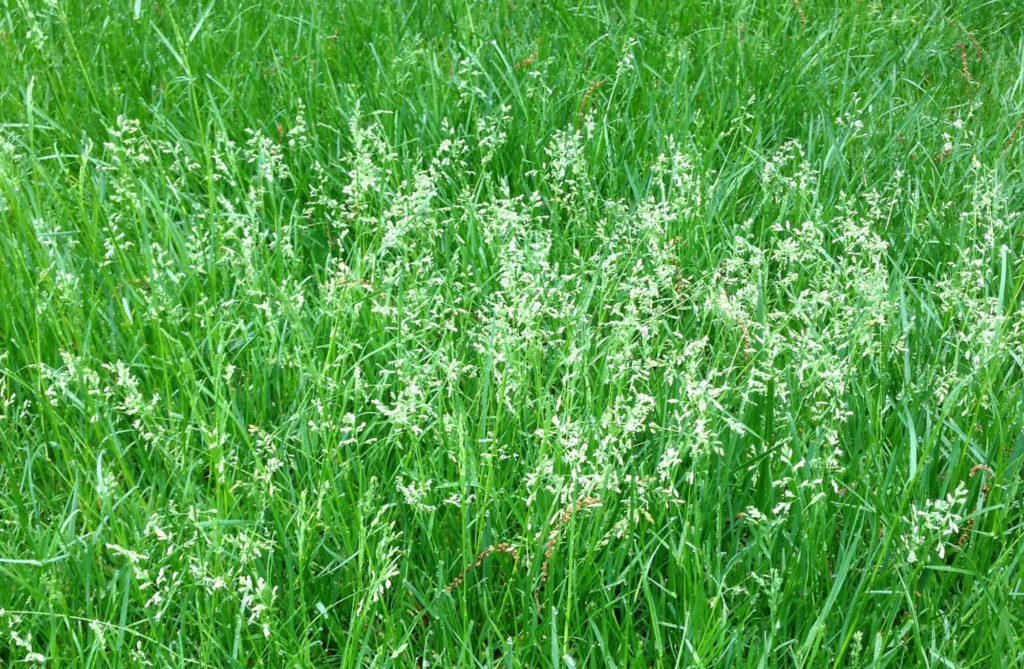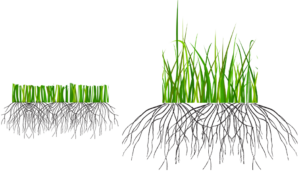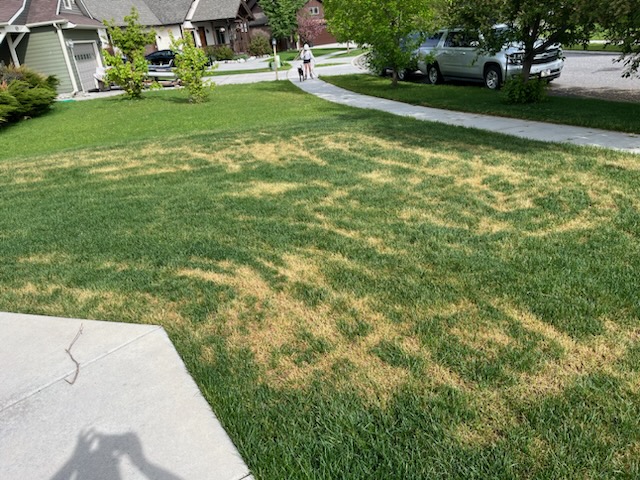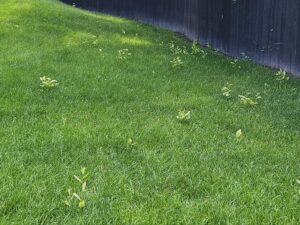Five Commonly Asked Summer Lawn Questions

We have the privilege of hearing all sorts of lawn questions about strange things people are seeing in their lawns all over the valley. We love taking great care of our customers and providing them with helpful information, so here are some of our most commonly asked questions about things you might be seeing in your turf this summer!
Dog Pee Spots

We’ll start with one that every dog lover will know: “How do I get rid of pee spots in my lawn?” Due to the high amount of nitrogen and salt in dog urine, most pups will leave discolored, bare or burnt spots on your lawn. When dogs are relieving themselves in the same spot on the lawn, the discoloration is more noticeable and may need some extra help.
The most severe cases of dog urine lawn damage result in brown spots, which are areas of dead and dying grass. Lawns that are dry or already weak and stressed are especially prone to this type of dog urine damage. Here are three tips to help bring those areas back to life!
- Water is the first remedy for any pee spot. Flush the area out with an ample load of water to rinse away the excess urine salts and help your grass come back to life.
- At this point, you could leave it and wait for the grass to return, but it may take a while. To give your lawn a hand, rake aside the dry grass, add a little topsoil, and overseed it with new grass seed.
- Finally, to ensure the new seed sprouts, remember to water it diligently for three weeks. If you give it a drink twice daily for the first week and once daily after that, you should have new blades emerging after just 2-3 weeks.
- Mow high! Set your lawnmower to its highest setting and your lawn will be stoked! (This will be a common theme for this blog.)
Grass Going to Seed
This one has been extra popular this year, with the wet spring weather we’ve had: “My lawn is full of weeds!” When we get that phone call, text or email, we might ask you to provide a photo so that we can better understand the weeds that we’re dealing with. Usually we expect dandelions or broadleaf weeds, but we also get several photos of grass going to seed. With good fertilization and lots of rain, your grass is doing what it was made to do and going to seed!
Most of our lawns are a blend of Kentucky Bluegrass and fescues- fantastic cool season grasses. These tolerate cold weather well and grow via rhizomes. Many other grasses require seed to germinate new grass, but Kentucky Bluegrass can spread and thicken by either seed or their rhizomes.
As our soil starts to warm up to a point where Kentucky Bluegrass seed would germinate, we have the perfect environment for it to take off and go to seed, thus the weedy appearance. Oftentimes, we miss it because we’re mowing before this appears, but when spring is rainy and you have awesome fertilizers being applied to your lawn, you’ve got the perfect recipe for Kentucky Bluegrass seed!
If your grass starts looking like this, no worries! A mow will take care of that and it also means that you’ve got a healthy and lush lawn! Way to go!

Dry Spots in Your Lawn
“I just have some really dry patches in my lawn!” Dry grass patches are areas of unhealthy grass. Over time, the soil in this area has begun to repel water rather than absorb it. This means the grass roots embedded within that section cannot soak up the water and nutrients they need. Eventually leading to the grass dying and the soil becoming bone-dry. There are a few reasons that you might see dry spots in your lawn that don’t seem to make any sense:
- High Traffic Area– if these are areas that have a lot of pet, sport or kid traffic, it’s easy for that turf to get worn down and compact.
- Pest infestations – pests and insects are not only an unpleasant thought, but once they bury under the soil, they’ll steal essential water and nutrients. Earthworms and grubs are some of the pests we see often.
- Fungal diseases – we’ll talk about the one we see most often here next!
- Lack of water – if it took a while to get your sprinklers rocking and rolling this year, your lawn might be extra thirsty. Even when we have rainy days in the spring, nothing’s better than a regular watering schedule!
- Mowing Short – setting your lawnmower to a low-cut setting can result in shallow grass roots and more sun exposure on your soil that dries out your turf. Mowing high is one of the best things you can do for your lawn!
The good news is that you can bring these areas back to good health with some pretty easy fixes!
Aeration– if the issue is compact soil, aeration can help to break that up! Whether you do a mechanical core aeration in the fall, or use our Liquid Aeration in the summer months- breaking up that compacted soil will help!
Deep Watering- your dry spots will be extra thankful for some deep watering! Three times a week, make sure that those spots get ½ an inch of water.
Fertilizing– we always recommend our Blended Organic Program for lawns that just need some extra love. The fertilizers will help your grass to develop a nice deep root system that helps your soil retain water.
Mow High– this is one of the easiest ways to keep your turf happy and healthy!
Look at those happy roots!

Melting Out

“My lawn is patchy and yellow! What happened?” What you’re seeing is a fungal disease called Ascochyta Leaf Spot, commonly known as “Melting Out.” The fungal spores are always present in your grass, but usually don’t affect the turf unless it’s stressed and unable to protect itself. When we get heavy snows and a quick warm up in temperature, we have the perfect environment for Melting Out to occur. Things might look worse before they look better, but your lawn will recover if cultural practices can be changed (more water and mowing at the tallest height). It takes roughly 2-3 weeks of good cultural practices to start to see a change.
Helpful Tips!
- Watering! As a general guideline if you have healthy soil, an inch and a half of water is recommended per week (be sure to follow watering regulations) and water in the morning between 4-8 am is the best!
- Mow High! This is SO important: taller grass = more plant tissue for photosynthesis, longer roots (they mimic the top growth), shaded soil to hold more water, and GREENER GRASS – the longer the leaf blade the more green there is.
- Now that you’ve put your mower to the maximum height, wait a week or two to mow. Allow the turf to come back and strengthen itself while maintaining or slightly increasing your watering schedule.
- Add more organics to the soil. More organics means more healthy bacteria and fungi that can help fight diseases like Melting Out. Just like our gut, when we add the right bacteria, our immune system is typically more strengthened and can outcompete sickness. Healthy soil full of organic material holds more water! This is a great place for me to recommend our Blended Organic lawn care program and Liquid Aeration application! They’re both full of great organic material that will help your lawn come back to good health.
Aspen Shooters:

We love our aspens out here and one thing that aspens love is growing in groves! One question that we’ll start to hear is “Can you get rid of my aspen shooters?” Also known as “suckers”; I had a customer call these “quakies” last year and I had never heard that! These are also easily mistaken for weeds, and not always welcome additions to your lawn or garden beds!
There are a few things that you can do to keep these from taking over your lawn:
- Remove the suckers by hand when you see them.
- Mow over them or prune them.
- Spray them with a selective broad-leaf herbicide to knock them back. (If you’re on one of our lawn care programs, we’re happy to do that for you!)
If you find yourself looking at your lawn and seeing any of these issues, we’d love to help!
 Billpay
Billpay
